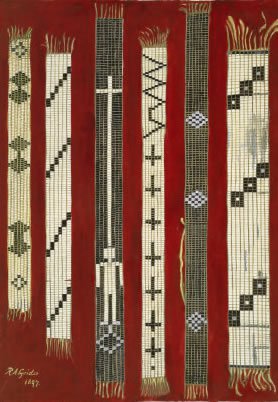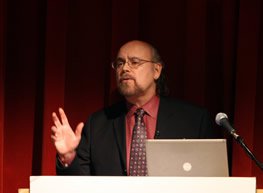SU, Onondaga Historical Association to explore role of wampum in Haudenosaunee culture Nov. 14-15
What really happened between French Jesuits and the Onondaga, more than three centuries ago?

Haudenosaunee oral history is the subject of an upcoming symposium in Syracuse University’s College of Arts and Sciences.
“Listening to the Wampum” will run Nov. 14-15 at various locations throughout Central New York and will explore the history of contact between French Jesuits and the Onondaga during the 1650s. The symposium is part of not only the Ray Smith Symposium, but also Syracuse Symposium™, whose theme this fall is “Listening.” Both symposia are sponsored by The College of Arts and Sciences.
“Listening to the Wampum” is organized and presented by the Onondaga Historical Association (OHA), in conjunction with The SU Humanities Center, Le Moyne College, Onondaga Community College (OCC), the Friends of Historic Onondaga Lake, and Skä-noñh—the Great Law of Peace Center. All events are free and open to the public. For more information, call OHA at 315-428-1864, ext. 314.
“No chapter of local history is probably more hotly contested than that involving French missionaries and the Onondaga,” says Philip Arnold, who is organizing the symposium with Gregg Tripoli, executive director of OHA, and with Holly Rine and Shawn Wiemann, history professors at Le Moyne and OCC, respectively. “At stake is the issue of whether or not the Onondaga rebuffed Jesuits’ attempts to convert them to Catholicism.”
Traditionally, Jesuit Relations, a collection of ethnographic documents chronicling missions in the New World, has been the source of such information. But Arnold and his team are confident a different account will emerge after the symposium.
Their argument hinges on something called a wampum belt, an arrangement of beads that Native Americans have long used to commemorate treaties and historical events. The wampum in question is the Remembrance Belt (also known as the Jesuit Belt), which, if interpreted properly, may bear witness to local events from 1653 and 1657-58.
“We will examine questions related to the role and meaning of wampum in Haudenosaunee [“People of the Longhouse” or Iroquois] culture,” Arnold says. “We also will discuss the role wampum plays in deriving an authoritative version of history.”
Arnold is founding director of Skä-noñh, a new facility on the eastern shore of Onondaga Lake, as well as associate professor of religion and Native American studies in SU’s College of Arts and Sciences.

“Listening to the Wampum” features an array of guest speakers, notably Davíd Carrasco, a Mexican-American historian of religions at Harvard University. The schedule is as follows:
Thursday, Nov. 14
Panel Discussion: “What Is Wampum?”
4-6 p.m.
Graham Commons, Bird Library, SU
Panelists: Rick Hill, coordinator of the Indigenous Knowledge Centre at Six Nations Polytechnic (Ohsweken, Canada); Arnold; and Wiemann
Reception with Haudenosaunsee artists and speakers
7-9 p.m.
Skä-noñh—Great Law of Peace Center (6680 Onondaga Lake Parkway, Liverpool)
Special Guests: Tonya Gonnella Frichner, president and founder of the American Indian Law Alliance; Irving Powless Jr. H'09, chief of the Beaver Clan and secretary of the Onondaga Nation; and Tripoli
Friday, Nov. 15
Lecture: “How Does a Story Look?: Walking an Indigenous ‘Mapa’ of Mexico”
11 a.m. to 12:30 p.m.
Mawhinney Auditorium, Onondaga Community College (4585 West Seneca Turnpike, Syracuse)
Guest Speaker: Davíd Carrasco, The Neil L. Rudenstine Professor of the Study of Latin America at Harvard Divinity School
Panel Discussion: “Listening to the Wampum in Dialogue with the ‘Jesuit Relations’”
3-5 p.m.
Grewen Auditorium, Le Moyne College (1419 Salt Springs Rd., Syracuse)
Panelists: Robert Sculley, professor and chair of history at Le Moyne; Oren R. Lyons ’58, H’93, faith-keeper of the Onondaga Nation’s Turtle Clan; and Rine
Moderator: David McCallum, interim dean of Madden School of Business and assistant professor of management, both at Le Moyne
The Ray Smith Symposium is enabled by a major bequest from the estate of Ray W. Smith ’21 and is administered by The College of Arts and Sciences. The symposium is named for the Auburn, N.Y. native who, after graduating from SU, became a highly respected teacher and administrator.
Founded in 2008, The SU Humanities Center is administered by The College of Arts and Sciences. The center fosters public engagement in the humanities and is home to The Central New York Humanities Corridor; the Watson Visiting Collaborator and Jeanette K. Watson Distinguished Visiting Professorship programs; the HC Mini-Seminar and Syracuse Symposium™ Seminar series; and other research initiatives, annual fellowships and public programming.
OHA has been licensed by Onondaga County to assume management of Skä-noñh, formerly known as Sainte Marie Among the Iroquois. The facility is undergoing planning and development to be repurposed as a Haudenosaunee cultural heritage center, in collaboration with the Onondaga Nation, SU, Le Moyne, OCC, SUNY College of Environmental Science and Forestry, and Empire State College.
Media Contact
Rob Enslin
